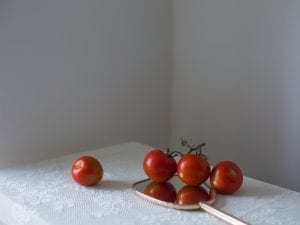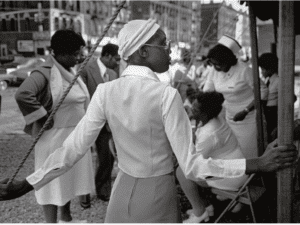Christiane Monarchi is the founding editor of the online magazine Photomonitor, which is dedicated to photography and lens-based media in the UK and Ireland, and has published more than 800 online features from 200 artists and writers in its first five years. Ahead of a panel discussion alongside Aesthetica, Corridor8 and Elephant Magazine at the Future Now Symposium, Monarchi expands on the unprecedented opportunities for images in the digital realm.
A: Having founded Photomonitor, why do you think that photography and lens-based media is increasingly becoming an important medium for artists to work in?
CM: I’ve asked many artists friends this question recently, to get a sense of what practitioners feel – and it ranges widely. The veracity of analogue, documentary, hand-printed, even unique works appeals to some, while other artists embrace digital image-making and tools, online sharing ability, story-telling, narrative and fictional possibilities inherent in creating and processing images through the digital realm. And somewhere on the spectrum is photobook authorship, which enables sharing large bodies of work, in whatever way they were created with the camera. It’s a fascinating spectrum to see artists moving through, and not just those trained in photography.
A: You are also a freelance curator, lecturer and Chair of the Board of Directors at Photofusion Photography Centre in the heart of Brixton. How have these experiences helped you in creating the publication?
CM: I’ve enjoyed getting to meet many artists, curators, gallerists, auction experts, authors and publishers in the past six years working on Photomonitor, and as I focus on UK and Irish artists and exhibitions there is quite a lot of overlap in terms of exhibiting artists, photobook authors, curators, academics. I enjoy being able to involve people in their area of photographic interest in Photomonitor, in an exhibition I’m curating, welcoming them to Photofusion, or possibly all three, particularly when I get to work with artists and photography professionals in Scotland, Ireland, and Wales as well, and hope to make connections with London where possible.
A: What do you think is Photomonitor’s biggest aim in terms of engaging with artists and creating dialogues internationally?
CM: We often have features on artists from outside the UK and Ireland who are showing in a gallery “here”, it’s important to add to the critical discussion of an artist’s practice in all of the places they exhibit. Equally Photomonitor is an important platform for those artists making work here, living here, who may not necessarily be showing at present – in a way, to provide a space to showcase work and ideas to readers “at home” and abroad. And being online the content stays visible forever, more than 800 features on artists seen around the world in more than 120 countries, that’s a great feeling to be able to share work so broadly.
A: How do you think that the online magazine is changing in terms of status and popularity?
CM: I’ve followed and read quite a few, and find the ones I gravitate towards welcoming a wide variety of voices, rather than a personal blog. Equally there are a few that are wonderful sources for images and visual inspiration, and perhaps offer less interesting text – it’s important to find a good balance between word and image.
A: Accessing more than 120 countries for your readership, do you think that the rise of online content is provoking more people to read and engage with culture? In which case is there a balance between the positive and negative sides to the internet?
CM: An interesting question, as I have often battled with the idea of spending too much time looking at the screen and not enough time engaging physically with the art. Online content should not be a substitute for personal experience and engagement with the arts, but rather give access to those things that may not be possible to experience in person – whether from geographic or physical constraint – in this way it is important to combine visual experience with critical thought to make a lasting, albeit virtual impression. Some of the readers we have from other continents may never experience some of the exhibitions or artworks in person, but I hope that reviews and interviews have helped to bring the ideas closer.
A: All your content is accessible to everyone, for free. How do you think that the digital landscape is asking important questions about the ethics of advertising, pay walls and the role of the editor?
CM: Separation of the advertising and editorial roles was important to me in setting up Photomonitor. It is our protocol to allocate commissioned features based on the ideas pitched to us by writers, rather than any “top down” allocation, so to ensure we don’t favour only the galleries with listings, and indeed, this way get to cover lots of smaller spaces as well as unrepresented artists who perhaps otherwise wouldn’t be as visible to viewers. This is something I think is important to maintain, even as we get larger and have more prominent galleries advertising with us. We don’t have a pay wall, all of our features are free to read, it’s something I’m quite proud of, making a searchable database of UK and Irish photography of the past six years. But of course I do want people to be able to click on the advertisers’ logos, they are on every content page, hanging out on the right in a vertical bar. It’s a photo-hub that I’ve wanted to build, and the advertising institutions are the cornerstone of this photography market, so it’s important to support them as they make new content possible for Photomonitor.
A: As you are taking part in the Future of Arts Journalism panel discussion at Future Now, what topics are you hoping to cover in terms of a discussion with Aesthetica, Corridor8 and Elephant, and what questions are you hoping to answer from the audience?
CM: I’m interested in the wider relationship between magazines, online content and social media, and how to best access and attract readership. How do people in the audience access content and what do they like to find for free? What should a magazine be posting on Instagram, for example? I’m also wondering how local the readers like their coverage, having set up Photomonitor on a UK and Irish geographic remit I’ve set up my parameters with this project, but watching others report from New York, Bangkok or Hong Kong, what is the right balance for a future project?
Book your place onto Session 11: The Future of Art Journalism: A Panel Discussion, 12:30 – 13:45 at the Future Now Symposium 2017. www.aestheticamagazine.com/art-prize/symposium-2017
Credits:
1. Meredith Glisson, is here | she (2015).





